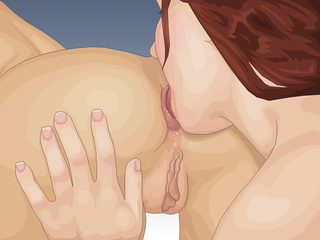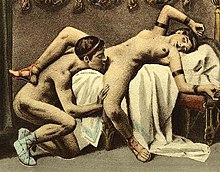Anal sex or anal intercourse is generally the insertion and thrusting of the erect penis into a person's anus, or anus and rectum, for sexual pleasure. Other forms of anal sex include anal fingering, the use of sex toys, anilingus, pegging, as well as electrostimulation and erotic torture such as figging. Although anal sex most commonly means penile–anal penetration, sources sometimes use anal intercourse to exclusively denote penile–anal penetration, and anal sex to denote any form of anal sexual activity, especially between pairings as opposed to anal masturbation.

In amniotes, the clitoris is a female sex organ. In humans, it is the vulva's most erogenous area and generally the primary anatomical source of female sexual pleasure. The clitoris is a complex structure, and its size and sensitivity can vary. The visible portion, the glans, of the clitoris is typically roughly the size and shape of a pea and is estimated to have at least 8,000 nerve endings.

Fellatio is an oral sex act involving a person stimulating the penis of another by using the mouth. Oral stimulation of the scrotum may also be termed fellatio, or colloquially as teabagging.

Human sexual activity, human sexual practice or human sexual behaviour is the manner in which humans experience and express their sexuality. People engage in a variety of sexual acts, ranging from activities done alone to acts with another person in varying patterns of frequency, for a wide variety of reasons. Sexual activity usually results in sexual arousal and physiological changes in the aroused person, some of which are pronounced while others are more subtle. Sexual activity may also include conduct and activities which are intended to arouse the sexual interest of another or enhance the sex life of another, such as strategies to find or attract partners, or personal interactions between individuals. Sexual activity may follow sexual arousal.

Orgasm or sexual climax is the sudden discharge of accumulated sexual excitement during the sexual response cycle, resulting in rhythmic, involuntary muscular contractions in the pelvic region characterized by sexual pleasure. Experienced by males and females, orgasms are controlled by the involuntary or autonomic nervous system. They are usually associated with involuntary actions, including muscular spasms in multiple areas of the body, a general euphoric sensation, and, frequently, body movements and vocalizations. The period after orgasm is typically a relaxing experience, attributed to the release of the neurohormones oxytocin and prolactin as well as endorphins.

Sexual intercourse is sexual activity involving the insertion and thrusting of the male penis inside the female vagina for sexual pleasure, reproduction, or both. This is also known as vaginal intercourse or vaginal sex. Sexual penetration has been known by humans since the dawn of time, and has been an instinctive form of sexual behaviour and psychology among humans. Other forms of penetrative sexual intercourse include anal sex, oral sex, fingering and penetration by use of a dildo, and vibrators. These activities involve physical intimacy between two or more people and are usually used among humans solely for physical or emotional pleasure. They can contribute to human bonding.

The G-spot, also called the Gräfenberg spot, is characterized as an erogenous area of the vagina that, when stimulated, may lead to strong sexual arousal, powerful orgasms and potential female ejaculation. It is typically reported to be located 5–8 cm (2–3 in) up the front (anterior) vaginal wall between the vaginal opening and the urethra and is a sensitive area that may be part of the female prostate.

The missionary position or man-on-top position is a sex position in which, generally, a woman lies on her back and spreads her legs and a man lies on top of her while they face each other and engage in vaginal intercourse. The position may also be used for other sexual activity, such as anal sex. It is commonly associated with heterosexual sexual activity, but is also used by same-sex couples. It may involve sexual penetration or non-penetrative sex, and its penile-vaginal aspect is an example of ventro-ventral (front-to-front) reproductive activity. Variations of the position allow varying degrees of clitoral stimulation, depth of penetration, participation on the part of the woman, and the likelihood and speed of orgasm.

Tribadism or tribbing, commonly known by its scissoring position, is a lesbian sexual practice involving vulva-to-vulva contact or rubbing the vulva against the partner's thigh, stomach, buttocks, arm, or other body parts, especially for stimulation of the clitoris. A variety of sex positions are practiced, including the missionary position.

Sexual penetration is the insertion of a body part or other object into a body orifice, such as the mouth, vagina or anus, as part of human sexual activity or sexual behavior in non-human animals.

Oral sex, sometimes referred to as oral intercourse, is sexual activity involving the stimulation of the genitalia of a person by another person using the mouth. Cunnilingus is oral sex performed on the vulva while fellatio is oral sex performed on the penis. Anilingus, another form of oral sex, is oral stimulation of the anus.

Fingering is sexual stimulation of the vulva or vagina by using the fingers. Vaginal fingering is legally and medically called digital penetration or digital penetration of the vagina. The term "digital" takes its significance from the English word 'digit', which refers to a finger, thumb, or toe. Fingering may also include the use of fingers to stimulate the anus.

A G-spot vibrator is a sex toy with female and male varieties. The female version of the device is built to massage the G-spot, described as a bean-shaped area of the vagina. Some women report that it is an erogenous zone which, when stimulated, can lead to strong sexual arousal, powerful orgasms and female ejaculation. The male version of the G-spot vibrator is used for massaging the prostate for both sexual and health-related reasons.

Non-penetrative sex or outercourse is sexual activity that usually does not include sexual penetration. It generally excludes the penetrative aspects of vaginal, anal, or oral sex, but includes various forms of sexual and non-sexual activity, such as frottage, manual sex, mutual masturbation, kissing, or cuddling. Some forms of non-penetrative sex, particularly when termed outercourse, include penetrative aspects, such as penetration that may result from forms of fingering or oral sex.

Sexual activities involving women who have sex with women (WSW), regardless of their sexual orientation or sexual identity, can include oral sex, manual sex, or tribadism.

Human female sexuality encompasses a broad range of behaviors and processes, including female sexual identity and sexual behavior, the physiological, psychological, social, cultural, political, and spiritual or religious aspects of sexual activity. Various aspects and dimensions of female sexuality, as a part of human sexuality, have also been addressed by principles of ethics, morality, and theology. In almost any historical era and culture, the arts, including literary and visual arts, as well as popular culture, present a substantial portion of a given society's views on human sexuality, which includes both implicit (covert) and explicit (overt) aspects and manifestations of feminine sexuality and behavior.

A handjob is a manual sex act involving a person stimulating the penis or scrotum of another by using the hand. This is done to induce an erection for sexual pleasure, sexual arousal and may result in orgasm and ejaculation.

Anilingus is an oral and anal sex act in which one person stimulates the anus of another by using their tongue or lips.
The following outline is provided as an overview of and topical guide to human sexuality:

Penile-vaginal intercourse or vaginal intercourse is a form of penetrative sexual intercourse in human sexuality, in which an erect penis is inserted into a vagina. Synonyms are: vaginal sex, cohabitation, coitus, intimacy, or (poetic) lovemaking. It corresponds to mating or copulation in non-human animals.





















